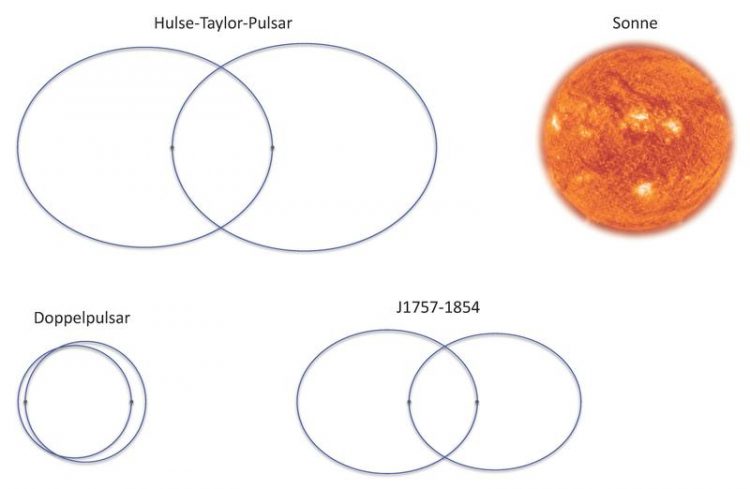Discovery of the most accelerated binary pulsar

The orbits of the new binary pulsar J1757-1854 in comparison to both, the famous Hulse-Taylor pulsar, and the double pulsar J0737-3039, so far the best cosmic laboratory for testing Einstein’s GRT. Norbert Wex/MPIfR (Sun: NASA/SOHO)
Although most of the more than 2,500 pulsars known are solitary objects, a few are found in tight binary systems. The discovery of the first of these, the Hulse-Taylor pulsar, famously won the Nobel Prize for “opening up new possibilities for the study of gravitation.”
This latest discovery was made as part of the High Time Resolution Universe Survey for pulsars using the 64-m Parkes telescope in Australia. The survey is a collaboration between the Australia Telescope National Facility, Istituti Nazionale di Astrofisica, Manchester University, Swinburne University and the MPIfR.
“The challenge is not in the observing but in the processing of the data, which requires huge amounts of computing power,” explains David Champion, an astronomer at the MPIfR and one of the PIs of the project. “We also had to develop new algorithms to search specifically for these accelerated systems.”
Using powerful computing clusters across the world, including the MPIfR’s ‘Hercules’ cluster located at the MPG’s computer centre at Garching, researchers were able to search their data in unprecedented detail for these rare objects.
The pulsar was discovered by Andrew Cameron, a PhD student at the MPIfR responsible for processing the data, “After going through 100s of 1,000s of candidates this one immediately stood out because of its large acceleration. I realised that it was potentially very exciting but it took months of detective work before we knew exactly what we’d found.”
The system was soon also being observed by Manchester University’s 76-m Lovell telescope, the 100-m Green Bank telescope, with collaborators at West Virginia University, and the MPIfR’s 100-m Effelsberg telescope.
The new system will be an excellent laboratory to test theories of gravity, including General Relativity.
“This system shows many similarities with the Nobel Prize winning binary, but this one is even more extreme,” concludes Norbert Wex, also at the MPIfR, an expert in testing gravity theories using pulsars. “Some GR effects are stronger than in any other binary pulsar. That makes it a great system to test Einstein’s theory.”
Contact:
Andrew Cameron
Max-Planck-Institut für Radioastronomie, Bonn.
Fon +49 228 525-181
E-Mail: acameron@mpifr-bonn.mpg.de
Dr. David Champion
Max-Planck-Institut für Radioastronomie, Bonn.
Fon +49 228 525-315
E-Mail: davidjohnchampion@gmail.com
Dr. Norbert Junkes,
Press and Public Outreach
Max-Planck-Institut für Radioastronomie, Bonn.
Fon: +49 228 525-399
E-mail: njunkes@mpifr-bonn.mpg.de
Media Contact
All latest news from the category: Physics and Astronomy
This area deals with the fundamental laws and building blocks of nature and how they interact, the properties and the behavior of matter, and research into space and time and their structures.
innovations-report provides in-depth reports and articles on subjects such as astrophysics, laser technologies, nuclear, quantum, particle and solid-state physics, nanotechnologies, planetary research and findings (Mars, Venus) and developments related to the Hubble Telescope.
Newest articles

NASA: Mystery of life’s handedness deepens
The mystery of why life uses molecules with specific orientations has deepened with a NASA-funded discovery that RNA — a key molecule thought to have potentially held the instructions for…

What are the effects of historic lithium mining on water quality?
Study reveals low levels of common contaminants but high levels of other elements in waters associated with an abandoned lithium mine. Lithium ore and mining waste from a historic lithium…

Quantum-inspired design boosts efficiency of heat-to-electricity conversion
Rice engineers take unconventional route to improving thermophotovoltaic systems. Researchers at Rice University have found a new way to improve a key element of thermophotovoltaic (TPV) systems, which convert heat…



